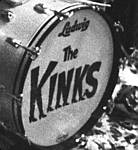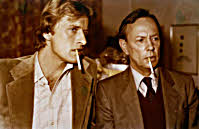
Making

The Technique
copyright:
all movie photos on this page © 1974 by Harrie Verstappen
all rights reserved
copyright notice


Wim Verstappen directs Filthon the Alicia page. It's shown in B/W, but was made on Eastmancolor negative ECNII. By now, you see what I mean or I give up: apart from coming in handy for those extra special effects, these cinema emulsions are no good for regular photography.
Then, there's the light. Contrary to popular thought (as so often happens, wrong) the light used for cinematography is not so intense at all: you need much more light for still photography, which explains why still photography used flash guns decades before cinematography got HMI strobe lights. To get the same view on a photograph as the film camera shows, you need a lens with at least twice the focal length, resulting in half the depth-of-field. To compensate for that, you need to close your diaphragm (stop down) one f-stop. Then, the movie camera uses a shutter speed of around 1/30-1/50th of a second; in still photography, the longest exposure recommended for hand-held shots on a 35mm camera is 1/100—another stop lost. As every stop down means losing half the light, we arrive at a level that's four times what the cinematographer needs.
But wait! It's even worse. At the time I was working for those movies, the image size of 35mm was really not good enough. This was because, like always in motion picture technique, the big problem was that everything you made had to be copied so many times before it could be shown to the public. And in the pre-digital days every copying step meant a severe loss in quality. The larger your original was, the smaller this problem. By then, most movie still photographers had stopped using 4"x5" Speed Graphics to switch to 6x6cm cameras (I used 6x9, further adding to my troubles). But even 6x6, with an 80mm standard lens, is bad enough. To get the same depth of field as the movie camera, you'd need about 8 times the light that's available on the set.
All this assuming the cameraman exposes correctly; those I have worked with (maybe not the absolute top?) invariably under-exposed by one or two stops in interiors. Something that, in a projected image, is often more acceptable than you might expect. However, on a paper print it's plain bad.

Kees Brusse - Ursula Blauth
Blue Movie
To sum it all up, while the movie camera was merrily grinding away at f2.8, I was schlepping a tripod around and exposing at 1/4 or, if I was lucky, 1/8 of a second at f3.5 (full open). Not always easy, you know. I have not even got around as yet to mentioning that the quality of most motion picture light is much too contrasty for normal 35mm photography. Look at that still from Blue Movie to see what I mean. You might well wonder by now why I didn't use a flash. For one, because the still photographs, as much as possible, have to look like the movie; often diffficult to start with. When you start changing the light, it becomes even harder. Then, certain scenes look great on film when you see only silhouettes; mostly, that just does not work on a photograph.
Only in Pastorale 1943 I gave up ("Uncle!" "Fingers!") and started using a fill-in flash. As long as I kept the flash level 2 stops below that of the movie lights, that worked. But in Grijpstra & de Gier, much to my regret, I was forced to go over the edge. Nobody ever complained about it, but some shots really still look extremely flashy to me.

Rutger Hauer - Rijk de Gooyer
Grijpstra & de Gier
And here, I had much faster lenses available, working on a Zenza Bronica 4.5x6 camera. It was good. its main advantage was that, instead of all the usual ironmongery, I mostly had only one camera around my neck and swapped magazines for B/W or color pictures. Before then, I had a Rittreck SLR 6x9cm, one 35mm (Contaflex Alpha, later Contax) for B/W and another one for color as my constant companions, with a Fujica 690 always on standby. You could hear me clunking by like a knight in full armor. Also the Linhof tripod, the Braun F900 flash with battery and the Sekonic Studio deLuxe exposure meter, extra lenses and film stock. All this added up to a substantial weight, which could get tiresome.
The two last films I worked for as a still photographer I used Contax all the way. Still Heavy Metal, mon... And don't forget that Glass... The aspherical f1.4 Zeiss lenses were heavy stuff indeed, but did at least give me a chance, with the cinematographer also having those high-speed lenses and highly pushable ECNII.
We're going Digital!
The stuff listed below dates from before I, not entirely wholeheartedly, had to give up and went out to buy a digital camera.
My thoughts and adventures on that interesting mishap are described here.
The Contaflex Alpha came with Zeiss Color Pantar half-interchangeable lenses: 4.0/30, 2.8/45 and 4.0/70mm. I used them all full-open anyway at 2.8. My quality requirements are not quite as stringent as Zeiss', and you always have to strike a balance between shutter speed and f-stop to get maximum sharpness under the particular circumstances. They also had a stereo adapter which was absolutely great. The Musashino Koki Rittreck 6x9 SLR was a beauty with the most fabulous viewfinder I ever had. It was clumsy to work with and made such a racket that when I had a misfire everybody on the set noticed. A Fujica 690 rangefinder was added to the force for Dakota, but was hard to use for close two-shots because of parallax. I bought my first Contax RTS in 1975 and never looked back. Also used up a 139 Quartz; still in use are a 167MT and Aria. The next one I'll have to buy will be digital. Which means buying new lenses—ugh. But that's why I opted for Contax in the first place, after all. |
film material For 35mm B/W, I used Kodak Plus-X (125ASA) and, if that was really too slow, Tri-X (400ASA), processed in Baumann Diafine; later I happily switched to Ilford 4X. Tri-X was only very rarely necessary. Color shots on Kodak Ektachrome EHB (High Speed Type B 125ASA, Tungsten), on 35mm and 120 film. For the prints, internegatives were made—mostly so badly that I finally did it myself for Mens-Erger-Je-Niet. I finally switched to Kodacolor-X, 100 ASA, developed in Tetenal chemicals to 200ASA, with B/W stills on Kodak Panalure panchromatic paper. But the main advantage was that Kodacolor was balanced between Tungsten (3200K) and Photographic Daylight (5600 K—"blue sky and white clouds"), and I was thus freed from the eternal hassles with color balance all movie work is subject to. For Dakota I did, for the sake of color continuity, filter all Daylight shots to Tungsten with an 85B filter, but the lab chief later told me those negatives were so weird—so I stopped using it. (It was easy to kick that habit). |
psychology
what makes a photograph look like a movie still
the routine
how to go about making movie stills
SEARCH this site or the Web

copyright notice
all photos, except where noted
copyright © 1974 by harrie verstappen , curaçao
all rights reserved
reproduction in any form for any purpose is prohibited
without prior consent in writing